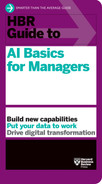Contents
Introduction: How AI Will Redefine Management
Five practices that successful managers need to master.
1. Three Questions About AI That Every Employee Should Be Able to Answer
How does it work, what is it good at, and what should it never do?
2. What Every Manager Should Know About Machine Learning
A nontechnical primer.
First, understand which technologies perform which types of tasks.
4. AI Doesn’t Have to Be Too Complicated or Expensive for Your Business
Focus on data quality, not quantity.
5. How AI Fits into Your Data Science Team
Get over the cultural hurdles and avoid exaggerated claims.
6. Ramp Up Your Team’s Predictive Analytics Skills
Three pitfalls they need to avoid.
7. Assembling Your AI Operations Team
A top-notch model is no good if your people can’t connect it to your existing systems.
8. How to Spot a Machine Learning Opportunity
What do you want to predict, and do you have the data?
9. A Simple Tool to Start Making Decisions with the Help of AI
Use the AI Canvas.
10. How to Pick the Right Automation Project
Invest in the ones that will build your organization’s capabilities.
11. Collaborative Intelligence: Humans and AI Are Joining Forces
They’re enhancing each other’s strengths.
12. How to Get Employees to Embrace AI
The sooner resisters get onboard, the sooner you will see results.
13. A Better Way to Onboard AI
Understand it as a tool to assist people rather than replace them.
14. Managing AI Decision-Making Tools
A framework to determine when and how humans need to stay involved.
15. Your Company’s Algorithms Will Go Wrong. Have a Plan in Place.
An AI designed to do X will eventually fail to do X.
16. A Practical Guide to Ethical AI
AI doesn’t just scale solutions—it also scales risk.
17. AI Can Help Address Inequity—If Companies Earn Users’ Trust
A case from Airbnb shows how good algorithms can have negative effects.
18. Take Action to Mitigate Ethical Risks
It starts with three critical conversations.
Taking the Next Steps with AI and Machine Learning
19. How No-Code Platforms Can Bring AI to Small and Midsize Businesses
Three features to look for as you consider the right tool for your company.
20. The Power of Natural Language Processing
NLP can help companies with brainstorming, summarizing, and researching.
21. Reinforcement Learning Is Ready for Business
Learning through trial and error can lead to more creative solutions.
22. How to Scale AI in Your Organization
Invest in processes, people, and tools.
Appendix: Case Study: Will a Bank’s New
Technology Help or Hurt Morale?
Weighing the benefits of AI against the downsides of impersonal decision-making.
